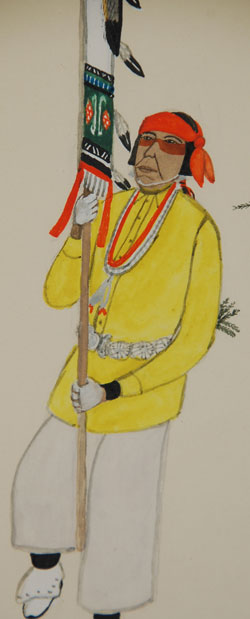Pueblo Fall “Corn Dance” Painting [R]
+ Add to my watchlist Forward to Friend
Forward to Friend
- Category: Paintings
- Origin: San Ildefonso Pueblo, Po-woh-ge-oweenge
- Medium: casein
- Size: 10-5/8” x 14-7/8” image x 12-1/2” x 16-3/4” framed
- Item # C3267C
- Price No Longer Available

This painting by Tonita Peña does not have a signature block in lower right in the manner that was usual for the artist. It is quite possible that a prior owner trimmed the paper to fit a pre-owned frame but there is no question that it is the work of the artist. All indication of format, line arrangement and facial features are those of Peña.
Peña was born at San Ildefonso Pueblo, but was sent by her father, following the death of her mother, to live with an aunt at Cochiti Pueblo at the age of 12. She spent the remainder of her life there.
Peña's usual treatment is concerned with several dance figures in a line led by a Corn Dance Banner Carrier and followed by a drummer. Generally, there are women in her paintings, and, as a rule, these women are taking a definite part in the dance as shown in the sensitive action of the feet. She presented the men with more active steps. This type of action, peculiar to Peña, is well illustrated here.
Tonita Peña was the only woman in the group of talented early pueblo artists referred to as The San Ildefonso Self-Taught Group, which included such noted artists as Julian Martinez, Alfonso Roybal, Abel Sanchez, Crecencio Martinez, and Encarnacion Peña. The men accepted her as an equal.
By the time she was 25 years old, she was a successful easel artist, and her work was being shown in museum exhibitions and in commercial art galleries in Santa Fe and Albuquerque. She painted what she knew best - scenes of life at the pueblo - mostly ceremonial dances and everyday events. She is still considered one of the best female Indian artists of all time and is recognized as the very first female Pueblo artist to pursue art as a career.
Condition: the painting appears to be in original condition
Provenance: from the collection of a family in Arizona.
Recommended Reading: Southwest Indian Painting a Changing Art by Clara Lee Tanner
- Category: Paintings
- Origin: San Ildefonso Pueblo, Po-woh-ge-oweenge
- Medium: casein
- Size: 10-5/8” x 14-7/8” image x 12-1/2” x 16-3/4” framed
- Item # C3267C
- Price No Longer Available



